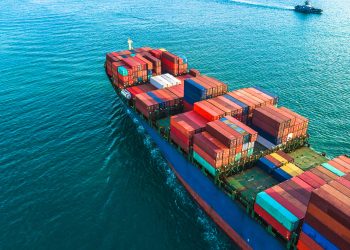In the third case of Swedish Club’s casebook with four different case studies related to fire, floodlights caused cargo fire on a bulk carrier.
The incident
A bulker had loaded sugar beet pellets in all three cargo holds with the operation taking 27 hours. When loading was completed the ventilation hatches and all other access points to the cargo holds were secured.
In cargo hold 1 there were two metres of space between the cargo and the cargo hatch. In cargo holds 2 and 3 the cargo was almost up to the hatch coaming.
Two days into the voyage the crew noticed smoke coming from cargo hold 2. Hot spots were discovered in hold 2 on the transverse hatch coaming, both forward and aft on the portside, and an additional hot spot was also discovered on hold 3 on the transverse hatch coaming, on the portside aft.
All hot spots were located adjacent to recesses in the coamings for the cargo holds’ floodlights.
The crew isolated the electrical power to the floodlights. Because of the increased temperature of the hot spots in hold 2, the Master released CO2 into the hold.
The CO2 did not extinguish the fire but reduced its severity for a while. When the vessel arrived at the discharge port the cargo hatches were opened, and flames broke out from hold 2. At the same time a plume of smoke escaped from hold 3. The top layer of cargo in hold 2 had been burned.
About 4 metres below the cargo surface the cargo was in good condition. It was discovered that the cargo in hold 3 had been damaged by condensation and tainted by smoke. There were clear burn marks around the floodlights and distinct burn marks by the coaming at the same locations where the hot spots had been discovered.
The floodlights were situated 1 metre below the cargo surface in holds 2 and 3 and there was black, burned cargo covering the floodlights. There were two floodlights fitted in cargo hold 1, port and starboard and four floodlights fitted in both cargo holds 2 and 3.
All the floodlights were installed in recesses in the hatch coaming. The floodlights were protected by round bars preventing crane hooks, grabs etc from hitting them, but these bars do not prevent cargo like sugar beet pellets from covering the lights.
The floodlights were controlled from the bridge on a panel with four key-switches. These switches were marked 1, 2, 3 and 4 respectively. No drawings or legends were attached clarifying which areas these key-switches served.
Lessons learned
- The subsequent investigation revealed that the cargo floodlights were not connected according to the approved ‘as built’ circuit diagrams delivered with the vessel. It was not clear on board which lights were controlled by which keyswitch.
- The fire was caused because a number of cargo lights were operating while cargo covered them, so the lights ignited the cargo. There was a lack of information on board about how the light circuits were connected and how the light system should be operated. There was also a lack of records concerning use of the lights.
- Many bulk carrier/general cargo holds have fixed cargo lights. Halogen-type lights can easily ignite combustible cargoes such as grain, animal feed, wood chips, pulp and paper if they are too close to the light.
- Cargo lights in holds need to be properly isolated before cargo is loaded. This is best done by removing fuses or other physical links in the electrical circuits so that the lights cannot be switched on by mistake. In container ships the lights need to be properly placed so that they do not overheat cargo or other combustibles and thus cause damage or fire. Lights in car carriers and ferries are usually fluorescent, which are unlikely to cause ignition. Nonetheless it makes sense to leave lights switched off when they are not needed, particularly in cargo areas where combustibles are present.





























































